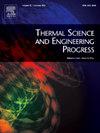Numerical investigation on the influence of the skid coolant temperature on the reheating furnace performance
IF 5.1
3区 工程技术
Q2 ENERGY & FUELS
引用次数: 0
Abstract
Steelmaking is among the most energy-intensive production processes, involving various furnaces for melting, reheating, or annealing at different stages. This study focuses on the reheating process, where steel slabs are moved through a hot furnace to reach temperatures suitable for hot rolling. This movement is facilitated by water-cooled skids that transport slabs along the furnace length, influencing both furnace efficiency and product quality. This paper examines the effect of increasing skid coolant temperature on furnace performance using computational fluid dynamics (CFD). The study adjusts coolant temperatures in the skids to observe impacts on furnace temperature distribution, slab heat fluxes, and overall charge quality. Using an experimentally validated truncated modelling approach, the furnace is analysed with a full-scale steady-state model, while the slab reheating process is evaluated with a truncated model. Furnace performance is assessed by examining temperature distributions and slab surface heat fluxes, while the reheating process is evaluated by analysing heat fluxes at skid-slab contacts, slab cross-sectional temperatures, and cold spot penetration depths. Findings indicate that increasing the skid coolant temperature to 350 °C can reduce reheating time by approximately 4–5 %, suggesting a notable improvement in furnace efficiency and slab quality through optimized skid cooling.
求助全文
约1分钟内获得全文
求助全文
来源期刊

Thermal Science and Engineering Progress
Chemical Engineering-Fluid Flow and Transfer Processes
CiteScore
7.20
自引率
10.40%
发文量
327
审稿时长
41 days
期刊介绍:
Thermal Science and Engineering Progress (TSEP) publishes original, high-quality research articles that span activities ranging from fundamental scientific research and discussion of the more controversial thermodynamic theories, to developments in thermal engineering that are in many instances examples of the way scientists and engineers are addressing the challenges facing a growing population – smart cities and global warming – maximising thermodynamic efficiencies and minimising all heat losses. It is intended that these will be of current relevance and interest to industry, academia and other practitioners. It is evident that many specialised journals in thermal and, to some extent, in fluid disciplines tend to focus on topics that can be classified as fundamental in nature, or are ‘applied’ and near-market. Thermal Science and Engineering Progress will bridge the gap between these two areas, allowing authors to make an easy choice, should they or a journal editor feel that their papers are ‘out of scope’ when considering other journals. The range of topics covered by Thermal Science and Engineering Progress addresses the rapid rate of development being made in thermal transfer processes as they affect traditional fields, and important growth in the topical research areas of aerospace, thermal biological and medical systems, electronics and nano-technologies, renewable energy systems, food production (including agriculture), and the need to minimise man-made thermal impacts on climate change. Review articles on appropriate topics for TSEP are encouraged, although until TSEP is fully established, these will be limited in number. Before submitting such articles, please contact one of the Editors, or a member of the Editorial Advisory Board with an outline of your proposal and your expertise in the area of your review.
 求助内容:
求助内容: 应助结果提醒方式:
应助结果提醒方式:


